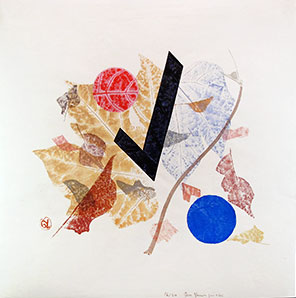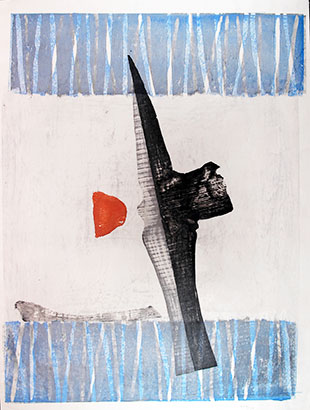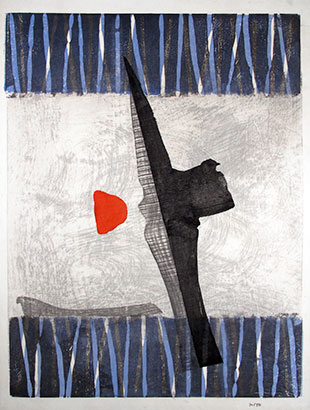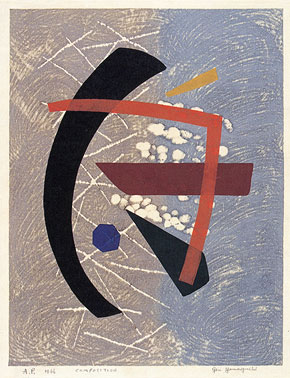

YAMAGUCHI Gen (山口源)
|
|||||||||||||||||||
 |
 |
| Yamaguchi Gen: Noh actor (能役者), woodcut, 1958 Image: 839 x 455 mm; Paper: 897 x 511 mm |
Yamaguchi Gen: Noh actor B (能役者 B), woodcut, 1958 |
| Yamaguchi arrived on the international art scene when he was awarded first prize at the International Print Biennale in Ljubljana, Yugoslavia in 1957, and a grand prix at the International Print Exhibition in Lugano, Switzerland in 1958 for "Noh Actor" (see above left and discussion below). He was the first Japanese artist to win the Lugano award. | |
Yamaguchi Gen (山口源) was born in Fuji City (Shizuoka Prefecture). He spent his youth in Tokyo, and thought for a time about becoming a writer, but after his family moved to Taiwan in 1914 (where they had prosperous beer and sake breweries), he had a chance encounter with Fujimori Shizuo (藤森静雄 1891–1943), an oil painter, sôsaku hanga artist, and friend of Onchi Kôshirô. Yamaguchi assisted Fujimori in collecting butterflies, while Fujimori introduced Yamaguchi to printmaking. Back in Japan, in 1932, Yamaguchi fell in with an anti-materialist group called Itto-en, which led him to renounce (for a time) financial support from his family and live an ascetic life. He survived with menial jobs, going house to house and offering to do chores. Serendipitously, he came to Onchi's home. As the Second World War approached, Yamaguchi spent time as an itinerant painter. He was a Christian (a legacy of childhood Sunday school taught by a missionary) and political liberal (though not a Communist), and was very much opposed to the militarism taking over Japan. For a few years, around 1935–37, he disappeared from the art scene, and may have been an activist in the anti-militarist underground.
Yamaguchi became an ardent admirer of Onchi Kôshirô and also befriended other sôsaku hanga artists (especially Azechi Umetarô, Maeda Masao, and Sekino Jun'ichirô). Self-taught, Yamaguchi once again accepted his family's support while he sketched and made prints. He was his own artist, independent and adventurous. A chance meeting with the printmaker Umetaro Azechi prompted Yamaguchi to become more active in making hanga, and in 1939 he became one of the original members in Onchi's Ichimoku-kai (First Thursday Society), participating in the group's informal monthly meetings held at Onchi's house (Yamaguchi lived nearby, as did Sekino Jun'ichirô) and contributing to all six of the portfolios issued by the group (1944, 1946-50). The following year, Yamaguchi submitted representational prints to the Kokugakai (National Picture Association: 国画会) and other exhibitions. After the war, he focused on non-representational works, including "object prints," using cardboard, netting, leaves, grass, string, cloth, and other found-objects in a style akin to Onchi's abstractions. He and Onchi shared some of the same attitudes toward printmaking, especially in regard to experimental techniques. Yamaguchi said, for example, that at about the same time, he and Onchi separately began making prints with media other than woodblocks.
Many of Yamaguchi's works were, like Onchi's, printed in only a single trial print or few impressions, and so are quite rare. It is also said that Yamaguchi sometimes found repeated printings of the same design somewhat tedious and so the number of known impressions of a given work is often rather small, regardless of edition numbers. Moreover, as these were overwhelmingly abstract works, he could play around with the positioning of forms or even turn certain compositions upside down (see the last two images on this page). Thus numbered editions (50 seemed to be his preferred size by the late 1950s) were not always fully printed. However, certain designs proved to be very popular and sold well, so occasionally Yamaguchi would issue second or even third editions, distinguishable by a change in the full edition number. For example, Poetry of Early Autumn (see below) was done in editions numbered 20, 30, and 50.
By the mid-to-late 1950s, Yamaguchi was exhibiting increasing mastery of block printing and a wide-ranging imagination in the creation of imagery, notably in very large formats. For the prize-winning design "Noh actor" (1958) shown above, Yamaguchi used, according to one source, "a weathered cedar board from an old fence [which] gave the artist his idea for this solemn Noh actor, whose straining intensity produces a keen, tangible atmosphere...." (see Yôshida and Yuki ref. below). The impressive scale (897 x 511 mm) was thus conveniently determined by a found object. Even so, Yamaguchi slightly modified the fence board with an aisuki (flat scraper) to accentuate the actor's profile, He used six different blocks in eight printing stages on torinoko (fusuma) paper with moderate sizing. The colorants were a combination of poster and powdered colors for the blacks, and five different gouache colors. The backgrounds were printed with thinned watercolors. As he progressed with printing the edition, Yamaguchi introduced changes in background textures and subtle color shifts among the various impressions. He also experimented with a rare (possibly unique) variant ("Noh actor B" above right), with the "face" of the actor flipped 180 degrees (printed from the opposite side of the fence board) and the shapes in the lower part of the composition replaced entirely.
 |
 |
| Yamaguchi Gen: "Poetry of early autumn" (早秋の詩) Mixed media (woodblock, stencils, leaves), 1948, ed. 30 Image: 245 x 285 mm; Paper: 362 x 360 mm |
Yamaguchi Gen: "Human beings" (人間達) 1956 Mixed media (wood, paper, cardboard blocks), ed. 50 Image: 463 x 374 mm; Paper: 533 x 423 mm |
A fairly early example of mixed media printing by Yamaguchi can be found in his "Poetry of early autumn" (早秋の詩) from 1948 (above left). At the time of writing his book, Statler (ref. below) cited the number of early impressions as seven, and assigning a date of 1947. Later, however, Yamaguchi also produced editions of 20, 30 (above left), and 50. Statler further provides details of the materials and process for making these impressions. Twenty blocks of natural leaves and three stencils were used in 23 printing stages. Poster colors were applied to torinoko paper. Yamaguchi made a kento (registration mark) on a piece of cardboard which bore pencil outlines to lay out the position of the leaves. Each leaf was placed separately on the cardboard and printed individually, some face up and others face down to vary the patterns made by the veins from impression to impression. The check mark and two circles were made with stencils cut from stiff paper. The result is an expressive autumnal collage punctuated by the large checkmark and a bright blue circle, the latter a favorite and much-used design element of Onchi, who considered the circle the most refined of forms.
Five years later, Yamaguchi experimented with wood, paper, and cardboard blocks for his print "Human beings" (人間達 above right). This design appears to have been printed in an edition of only three in 1953, followed by an edition of 50 in 1956 (as above). Oliver Statler (ref. below) identified the materials. The blocks were complex, consisting of a plywood block faced with shina, an uncarved solid katsura on which wrapping-paper blocks for the faces were pasted, five blocks of plain cardbaord, and two blocks of corrugated cardboard. Poster colors were used on masagami paper. "The background and faces were printed from the uncarved block of solid katsura, on which were pasted the face blocks of wrapping paper. Thinly diluted grey color was brushed over the entire block, but the paper repelled the color and printed much whiter. The noses, mouths, and eyes were carved on the plywood, the bodies were printed from the five blocks of plain cardboard, and the lines around the heads were printed from corrugated cardboard." Yamaguchi's modernist image has had a powerful impact on many observers. The mask-like universalist faces seem to represent all of mankind and could very well express the lingering plight of post-war Japan.
 |
 |
| Yamaguchi Gen: "Deep attachment" (想慕), 1957 Mixed media (woodblock, found-object), ed. 4/50 Image: 585 x 438 mm; Paper: 635 x 468 mm |
Yamaguchi Gen: "Deep attachment" (想慕), 1957 Mixed media (woodblock, found-object), ed. 30/50 Image: 585 x 438 mm; Paper: 635 x 468 mm |
Yamaguchi followed his own instincts, experimenting constantly and manipulating his materials and images as he sought to achieve satisfying results. One design that varies substantially from impression to impression is Yamaguchi's "Deep attachment" (想慕) from 1957 (see below). Certain prominent early Western collectors of Yamaguchi's prints declared this design "subtle and perfect" (Michener) and "a design in which every element seems necessary and in exactly the right place" (Statler). Michener further wrote, "When Yamaguchi Gen was in the midst of making the print ... he wrote me a letter that summarizes the problems which have always beset Japanese print artists: 'For many years I have been working at my art and at times I have not had the courage to go ahead. I have had to watch the work done by men like me ignored, abused, and left unsold. Some critics avoid us because we do not work in the old style, and others say harsh things because we do not copy old Japanese themes. It has been a very hard life indeed to bear such indifference and recently I have often thought about stopping. But the great interest you and Mr. Statler have shown in my work makes me believe that I am doing right. So I keep working'." Michener added, "... the print that came out of the spirit of that letter ... is a marvelous, poetic thing, and I would be gratified beyond expression if I thought that anything I had said had encouraged a man to stay at such work."
 "Deep Attachment" (shown above) is a large-format, mixed media work, printed with woodcut and found-object. The edition size is 50. The impression above left is a soft and subtle rendering of the image. There is a sense of quiet, lightness, and open space. The version on the right is bold and dramatic. Deeper, more contrasting colors are used throughout the image (note the differences between the red forms) and prominent marks from baren-sujizuri (baren traces printing), which are barely visible in the first impression, have become an important design element as they swirl about the central background. The driftwood form, which is lightly printed and shows variable density in its texture (above left), is printed with heavy consistency in the dark values (above right), filling in much of the detail in the form.
"Deep Attachment" (shown above) is a large-format, mixed media work, printed with woodcut and found-object. The edition size is 50. The impression above left is a soft and subtle rendering of the image. There is a sense of quiet, lightness, and open space. The version on the right is bold and dramatic. Deeper, more contrasting colors are used throughout the image (note the differences between the red forms) and prominent marks from baren-sujizuri (baren traces printing), which are barely visible in the first impression, have become an important design element as they swirl about the central background. The driftwood form, which is lightly printed and shows variable density in its texture (above left), is printed with heavy consistency in the dark values (above right), filling in much of the detail in the form.
Another work of exceptional amplitude, made in 1959, is titled "Germination" (萌芽期); see image at right. Yamaguchi used seven blocks of shina-faced plywood, torinoko paper, and poster colors for an edition of 50 impressions. "Germination," as printed here, would seem to be a transitional work, as the five forms placed over the light-blue-gray woodgrain-patterned rectangle are edging toward a certain hardness, uniform color, and crisp contour line that would increasingly characterize Yamaguchi's later oeuvre.
Kawakita (ref. below) wrote of "Germination" that, "The print ... is a kind of stylized abstraction, done in quiet tones, of the countryside at the season of new buds, [and] can also be seen as a kind of inner or spiritual landscape depicting the burgeoning of hope in the human mind." However, compared to the Kawakita illustration, the less "quiet" example shown on the right raises the chromatic intensity by substituting a bright yellow for a more subdued light-brown color and boosting the contrast between the background and the various forms. It would seem that pinning down a single meaning for Yamaguchi's prints might be an exercise in futility, especially given the artist's distain for print titles (see next paragraph).
In following his own instincts, Yamaguchi experimented continuously as he manipulated materials and images. Illustrated below left is an untitled abstract from 1962, numbered 2/50 and printed on paper measuring 531 x 403 mm. Yamaguchi later reworked this design, calling it simply "Composition" (Konpojishon: コンポジション) dated 1966 as an artist's proof (A.P.). Yamaguchi turned the earlier image upside down and added two small shapes (blue and yellow). Moreover, the orange L-shapes, while similar, were not printed from the same color block. Curiously, there is a known impression (1 of 50) with a label pasted on the back reading "Desire at the Rocks," but whether Yamaguchi ever applied that title consistently to this design has not been confirmed. Regardless, Yamaguchi considered print titles unnecessary. Often, he was merely satisfying the wishes of buyers who wanted titles associated with the prints. Sometimes the words had a certain appeal and did not reflect the content or meaning of a print. Yamaguchi could be mischievious in this regard. Petit (see ref. below) mentions that a print titled "Fedrifuge" denoted "the name of an anti-fever medication; an empty box of this happened to be standing on his table at the time he was ready to title this print."
_290w.jpg) |
 |
| Yamaguchi Gen: "Composition" (コンポジション), 1962 Image: 458 x 439 mm; Paper: 531 x 403 mm (2/50) |
Yamaguchi Gen: "Composition" (コンポジション), 1966 Image: 457 x 347 mm;; Paper: 531 x 403 mm (A.P.) |
Yamaguchi died in 1976 in Enoura, Numazu City. His family presented 228 of his works to the City of Numazu in 1981 and the Yamaguchi Gen Prize was established in 1984 to recognize and encourage young artists. Yamaguchi's prints can be found in many of the most important institutional collections in the world, including the Art Institute of Chicago; Asian Art Museum, San Francisco; British Museum, London; Brooklyn Museum, New York; Fine Art Museums of San Francisco; Harvard Art Museums; Honolulu Museum of Art; Museum of Modern Art, New York; National Museum of Modern Art, Tokyo; Portland Art Museum, Oregon; and Shizuoka Prefectural Museum of Art, Japan © 2020-2021 by John Fiorillo
BIBLIOGRAPHY
- Catalogue of Collections [Modern Prints]: The National Museum of Modern Art, Tokyo (Tokyo kokuritsu kindai bijutsukan shozô-hin mokuroku, 東京国立近代美術館所蔵品目録). 1993, pp. 257-258, nos. 2480-2484.
- Retrospective Exhibition of Gen Yamaguchi, 100th Anniversary of the Artist's Birth; Art in Shizuoka No. 8; Shizuoka Prefectural Museum of Art (Shizuoka Kenritsu Bijutsukan: 静岡県立美術館), 1998, no. 137.
- Jenkins, Donald: Images of a Changing world: Japanese Prints of the Twentieth Century. Portland Art Museum, 1983, no. 92, p. 111.
- Kawakita, Michiaki: Contemporary Japanese Prints. Tokyo: Kodansha, 1967, pp. 18-19, no. 10.
- Michener, James: Japanese Prints: From the Early Masters to the Modern. Rutland, VT: Tuttle, 1959, pp. 238-239, 280; no. 245
- Petit, Gaston: 44 Modern Japanese Print Artists. Tokyo: Kodansha, 1973; vol. 2, pp. 174-181, nos. C78-C80, 235-240; and descriptive list of plates, pp. 53-54.
- Sakai, Tetsuo et al.: Mô hitotsu no Nihon bijutsushi kin gendai hanga no meisaku 2020 (Another History of Japanese Art: Masterpieces of Modern and Contemporary Prints 2020: もうひとつの日本美術史近現代版画の名作2020). Fukushima Prefectural Museum of Art and Museum of Modern Art, Wakayama, 2020, p. 145, no. 8-9.
- Statler, Oliver: Modern Japanese Prints: An Art Reborn. Rutland & Tokyo: Tuttle, 1956, pp. 154-158 and 200-201; color plate facing p. 154; b/w figures 88-89.
- Yoshida, Tôshi and Yuki, Rei: Japanese Print Making. Rutland & Tokyo: Tuttle, 1966, pp. 150-155 and color plate 11 (p. 95).
Viewing Japanese Prints |